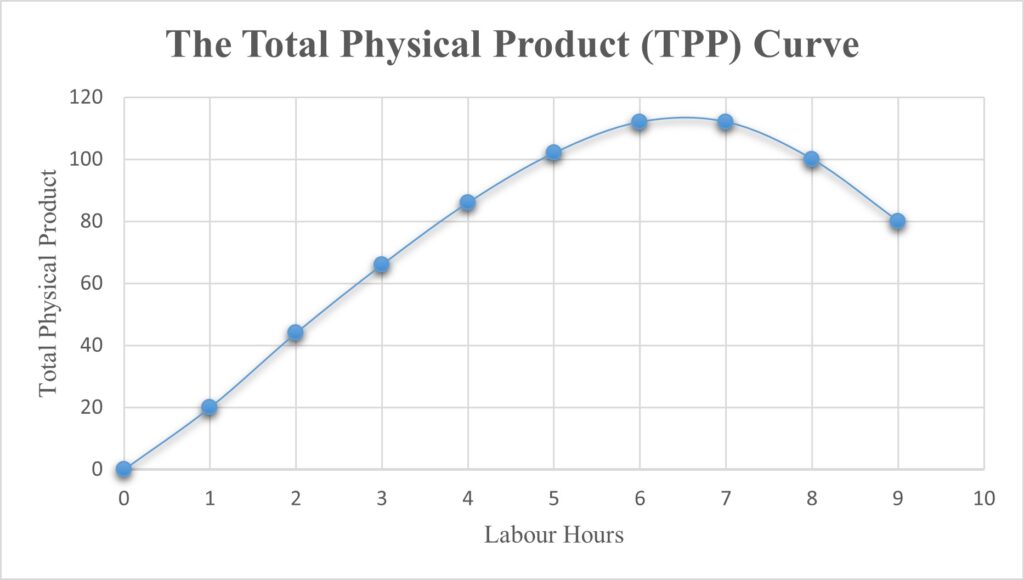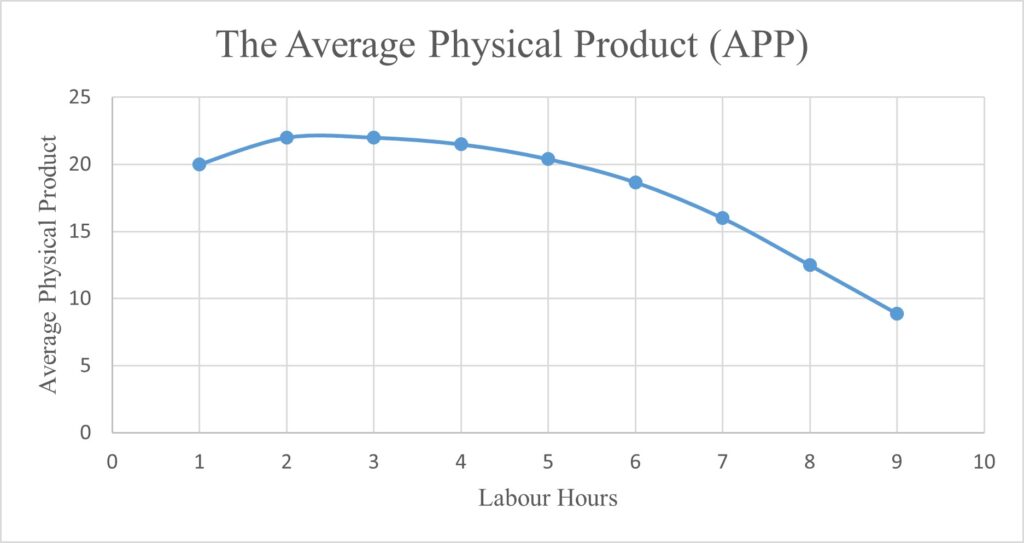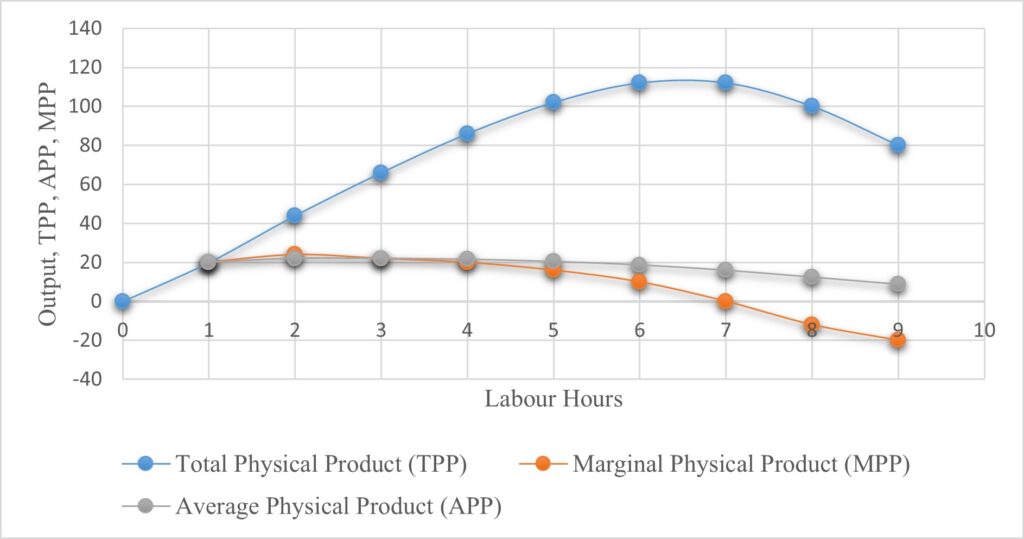Contents
Meaning of Production
In economics, production means the creation of utility for sale. The act of creating utility is done by transferring a set of inputs into some output of good or service. The output has a greater utility than the inputs together. Thus, output or new product created is sold in the market. If it is not marketed, it is not taken as production in an economic sense but technologically it is production.
The inputs used in the production may be goods either supplied by the nature or produced by other industries. These are known as intermediate inputs or material inputs. In economics, inputs are defined as actors of production such as workers, land, building, plant, machines, tools and equipment, and managers. Such inputs are used repeatedly in the process of production. They are used to convert the material inputs into output and such inputs are also called primary inputs. Some examples of production are mentioned as production of goods in factories, production of services such as teaching to students, production of agriculture goods, etc.
The concept of production can be understood clearly with the help of a flow diagram as shown below.

The main aim of production is to convert raw materials and other produced inputs into outputs. This can be done in the technology box with the help of men/workers and machines including other equipment. To make men and machines operative there is a need for fuel and power which is also a category of inputs. From the technology box, we get output in the form of the desired product (s) and may get some by-products from this.
The essence of production theory is a firm or a factory which is considered as the smallest technical unit of production. A firm may be considered as an organizational unit engaged in some business activities. By organization, we mean a union of people having different functions but working under a single administrative set-up, duly constituted according to the law of the state. It has a common goal for all its members such as profit maximization or sales maximization.
Therefore, the act of production involves the conversion of inputs into output in the form of physical products as well as services like transporting, financing, and marketing, etc.
Concept of Total Product (TP), Average Product (AP), and Marginal Product (MP)
Total Product (TP)
The total product also known as the total physical product of an input, denoted by TP or TPP, is defined as the total output associated with a given level of employment of the inputs in each period. So, TP is the total amount of output produced by a firm or an industry hiring various units of inputs in a time is known as total product.
The major features of the total product are pointed below.
- It is the sum of all successive marginal products of an input
- It is the result of efforts of all factors of production like land, labor, capital, and organization
- It is also the product of average product (AP) and the number of factor inputs used in the production process
- The total product increases at the increasing rate, thereafter, it increases at decreasing rate and become maximum and finally, it starts to fall
For the measurement of the total product (TP) the following formulas are used.
TP= MP1+MP2+MP3+…. +MPn=∑MP
Where TP stands for the total product; MP stands for marginal product
Total product is also obtained by multiplying the average product by units of labour or any other variable input. It is expressed as
TP=AP×N
Where AP stands for average product and N stands for the number of factor inputs
Average Product (AP)
The average product (AP) or the average physical product (APP) is defined as the total product divided by units of factor inputs used in the production process. In other words, AP is the output per unit of factor input.
Major features of the average product are listed below
- It is TP or TPP per unit of the variable input
- Average product is calculated by dividing the total product of an input by the corresponding unit of that input
It can be measured using the following formula
AP=TP/N
Where AP stands for average product, TP stands for total product and N stands for units of factor input
Therefore, the average product of labor and capital will be calculated by using the following formula
APL=TP/L and APK=TP/K
Where APL stands for average productivity of labor and APK stands for average productivity of capital.
Marginal Product (MP)
The marginal product (MP) or the marginal physical product (MPP) is defined as the increase in the total physical product per unit increase in the employment of an input. It also can be defined as the ratio of change in total product and change in units of labor or any other variables input.
The major features of the marginal products are listed below.
- It is the addition in the total product because of one additional unit increase in labor or any variable input
- The marginal product may be zero and even negative
The measurement of the marginal product (MP) can be done with help of the following formula.
MP=ΔTP/ΔN
Where MP stands for marginal product, ΔTP stands for change in total product, ΔN stands for change in factor input
Alternatively, it can also be calculated by using the following formula.
MP= TPn-TPn-1
Where TPn is the total product from the nth unit of factor inputs and TPn-1 is the total product from (n-1) th unit of factor input.
The marginal productivity of labor and capital can be calculated by using the following formulas.
MPL= ΔTP/ΔL and MPK= ΔTP/ΔK
Things to Recall
Total Product (TP): The total amount of output produced by a firm or an industry by employing several inputs in each period is known as total product.
Marginal Product (MP): The additional output produced by a firm or an industry by employing one more unit of input is called marginal product.
Average Product (AP): The per-unit product of an input is called the average product.
The following table shows the total product, marginal product, and average product schedule where the variable input is labor hour L. Total physical product initially increases at an increasing rate, then at decreasing rate, reaches the maximum and starts to fall.
The marginal physical product (MPP) can be obtained from the total physical product (TPP). For example, the MPP at L=2 is 24, which is equal to the difference between TPP at L=2, which is 44, and at L=1, which is 20. The value of MPP initially rises, reaches a maximum point, and then begins to decline. When TPP is maximum, MPP is zero and when TPP falls, MPP is negative.
Similarly, the average physical product (APP) is derived by dividing TPP by labour unit L. It increases at a decreasing rate, reaches a maximum point, and then begins to decline. As long as TPP is positive, APP is also positive.
| Labour Hours Employed (L) | Total Physical Product (TPP) | Marginal Physical Product (MPP) | Average Physical Product (APP) |
| 0 | 0 | – | – |
| 1 | 20 | 20 | 20 |
| 2 | 44 | 24 | 22 |
| 3 | 66 | 22 | 22 |
| 4 | 86 | 20 | 21.5 |
| 5 | 102 | 16 | 20.4 |
| 6 | 112 | 10 | 18.7 |
| 7 | 112 | 0 | 16 |
| 8 | 100 | -12 | 12.5 |
| 9 | 80 | -20 | 8.9 |
The Total Product, Marginal Product, and Average Product Curves
The TPP, MPP, and MPP Curves Corresponding to the Above Table

The above figure shows the total physical product curve. It follows the pattern like initially, it increases at an increasing rate, then increases at a decreasing rate, reaches a maximum point, and then declines.
The following graphs show the marginal physical product curve and the average physical product curve, respectively. We see both the MPP and APP initially increase and then decrease. Further, after a certain point, MPP becomes negative. Both curves are inverse U-shaped curves since MPP, and APP initially increases then decrease.


Relationship between TP, AP, and MP of Labour in Short Run
The nature and association between the total physical product (TPP), the average physical product (APP), and the marginal physical product (MPP) in the short run are shown in the following diagram (graphical illustration of the above table).

In the process of producing goods, when labour as factor input is increased keeping all other factors constant, the following relationships are established between TP, AP, and MP.
Relationship between TP and MP
- When MP is rising, TP is increasing at an increasing rate
- When MP is falling, then TP increases at decreasing rate
- When MP becomes zero, TP becomes maximum
- When MP becomes negative, TP begins to fall
Relationship between AP and MP
- In the beginning, when more and more units of labors are hired, AP and MP both are increasing but MP rises faster than AP
- When MP reaches a maximum point and starts to decline, then AP becomes maximum
- When AP becomes maximum, AP and MP both start to fall. But MP falls faster than AP.
- MP may be zero and even negative, but AP is always positive.
- MP is not constant at the maximum point, but AP is constant at the maximum point.